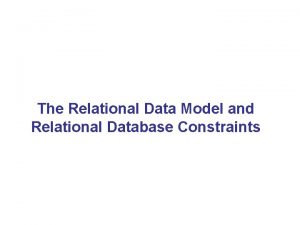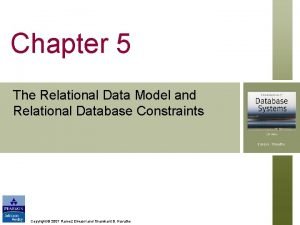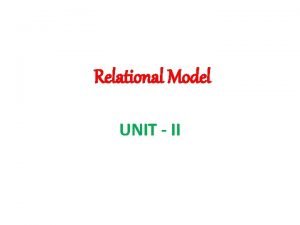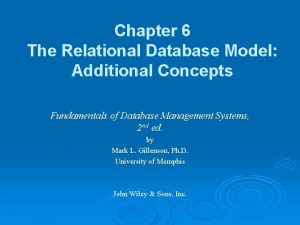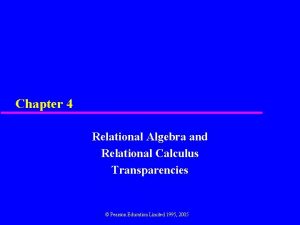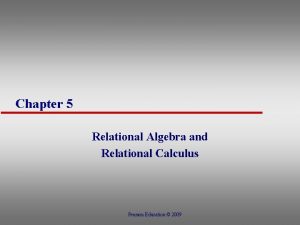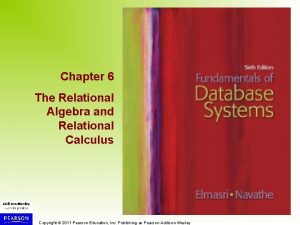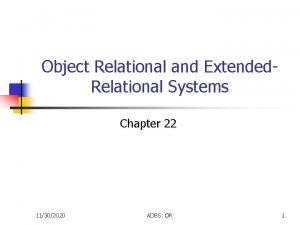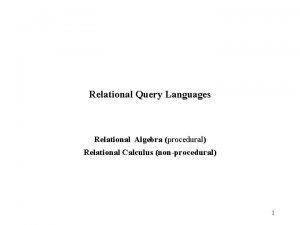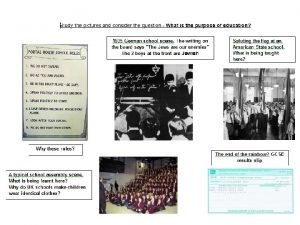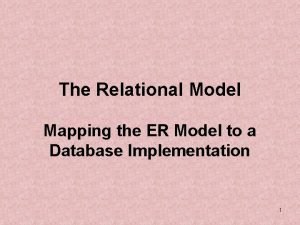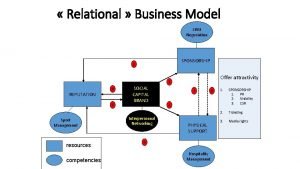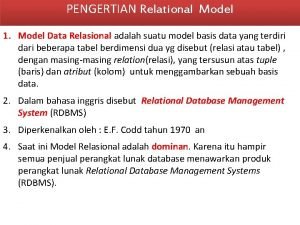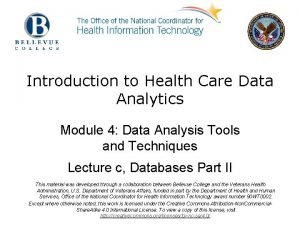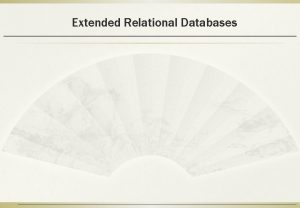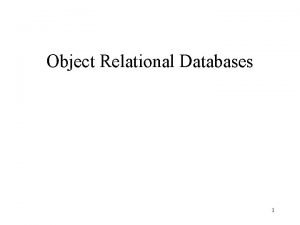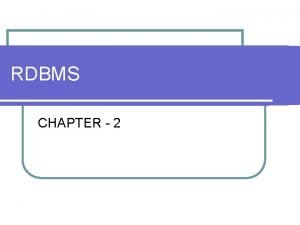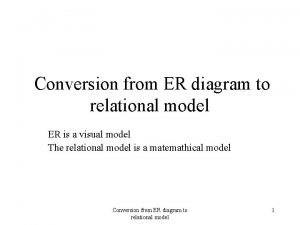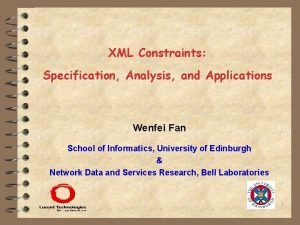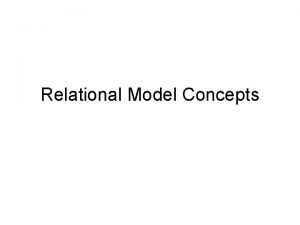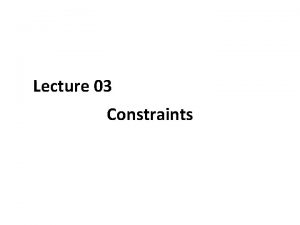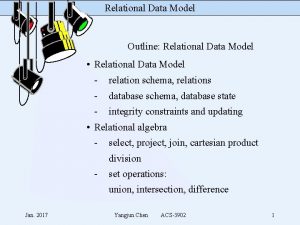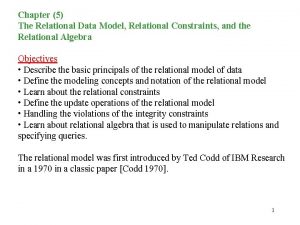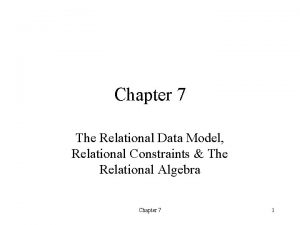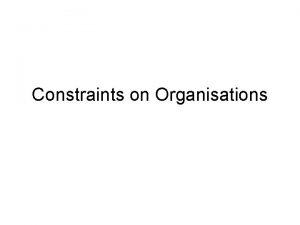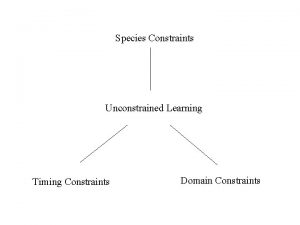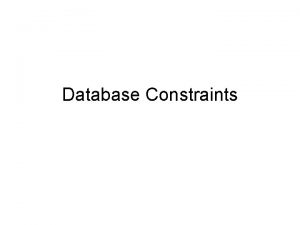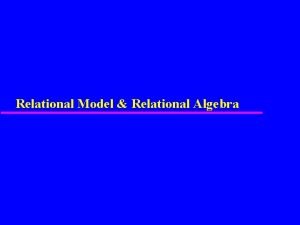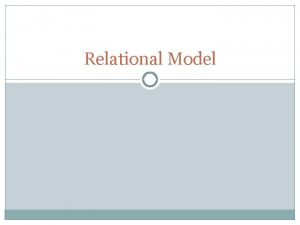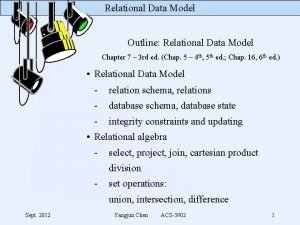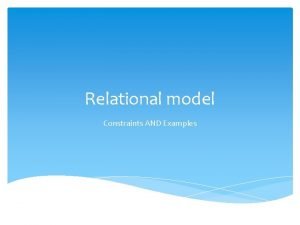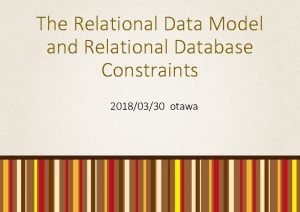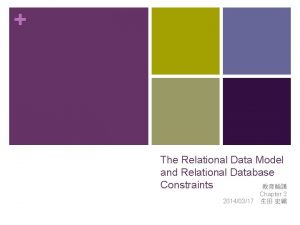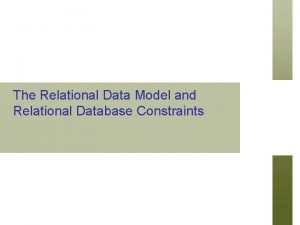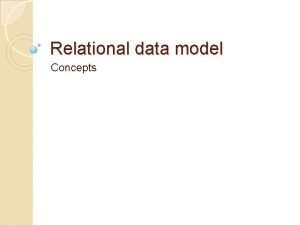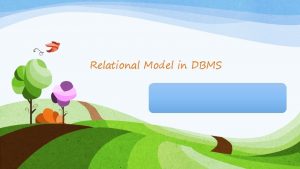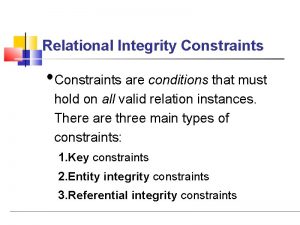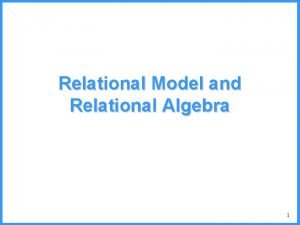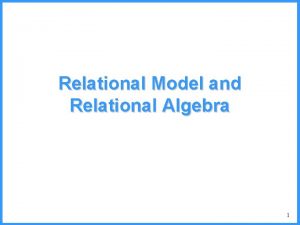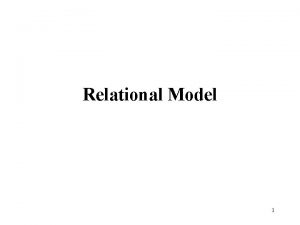Chapter Outline Relational Model Concepts Relational Model Constraints




























- Slides: 28

Chapter Outline • Relational Model Concepts • Relational Model Constraints and Relational Database Schemas • Update Operations and Dealing with Constraint Violations

Relational Model Concepts • The relational Model of Data is based on the concept of a Relation. • A Relation is a mathematical concept based on the ideas of sets. • The strength of the relational approach to data management comes from the formal foundation provided by theory of relations. • We will review the essentials of the relational approach in this lecture.

Relational Model Concepts • The model was first proposed by Dr. E. F. Codd of IBM in the following paper: "A Relational Model for Large Shared Data Banks, " Communications of the ACM, June 1970. • This paper caused a revolution in the field of Database management and earned Ted Codd the coveted ACM Turing Award.

Informal Definitions • Relation: A table of values – A relation may be thought of as a set of rows. – (A relation may alternately be thought of as a set of columns. ) – Each row represents a fact that corresponds to a realworld entity or relationship. – Each row has a value of an item, or set of items, that uniquely identifies that row in the table. – Sometimes row-ids or sequential numbers are assigned to identify the rows. – Each column typically is called by its column name or column header or attribute name.

Attributes and Tuples of the STUDENT Relation

Formal Definitions - 1 • A Relation may be defined in multiple ways. • The Schema of a Relation: R (A 1, A 2, . . . An) • Relation schema R is defined over attributes A 1, A 2, . . . An – e. g. CUSTOMER (Cust-id, Cust-name, Address, Phone#) • CUSTOMER is a relation defined over the attributes Cust-id, Cust-name, Address, Phone#, each of which has a domain (set of valid values), – e. g. the domain of Cust-id is 6 digit numbers.

Formal Definitions - 2 • A tuple is an ordered set of values • Each value is derived from an appropriate domain. • Each row in the CUSTOMER table may be referred to as a tuple in the table and would consist of four values. – e. g. <632895, "John Smith", "101 Main St. Atlanta, GA 30332", "(404) 894 -2000"> is a tuple belonging to the CUSTOMER relation. • A relation is a set of tuples (rows). • Columns in a table are also called attributes of the relation.

Formal Definitions - 3 • A domain has a logical definition: e. g. , USA_phone_numbers are the set of 10 digit phone numbers valid in the U. S. • A domain may have a data type or a format defined for it, e. g. – USA_phone_numbers may have the format: (ddd)-dddd. – Dates have formats such as month-name, date, year or yyyy-mm-dd, or dd, mm, yyyy etc. • An attribute designates the role played by the domain. E. g. , the domain Date may be used for attributes “Invoice-date” and “Payment-date”.

Formal Definitions - 4 • The relation is formed over the Cartesian product of the sets; each set has values from a domain; that domain is used in a specific role which is conveyed by the attribute name. • E. g. , attribute Cust-name is defined over the domain of strings of 25 characters. Formally, Given R(A 1, A 2, . . , An) – r(R) dom (A 1) X dom (A 2) X. . X dom(An) • • R: schema of the relation r of R: a specific "value" or population of R. R is also called the intension of a relation r is also called the extension of a relation

Formal Definitions – 5. • Let S 1 = {0, 1} • Let S 2 = {a, b, c} • Let R S 1 X S 2 • Then for example: r(R) = {<0, a>, <0, b>, <1, c>} is one possible “state” or “population” or “extension” r of the relation R, defined over domains S 1 and S 2. It has three tuples.

Summary of Definitions Informal Terms Table Column Row Values in a column Table Definition Populated Table Formal Terms Relation Attribute/Domain Tuple Domain Schema of a Relation Extension


Exercise • What is the domain of each attribute of the EMPLOYEE relation? • Assume that the example on the previous slide shows the complete domain of the EMPLOYEE relation in this mini-world – What is the size of the relation?

Characteristics of Relations • Ordering of tuples in a relation r(R): tuples are not considered to be ordered, even though they appear to be in the tabular form. • Ordering of attributes in a relation schema R (and of values within each tuple): We consider the attributes in R(A 1, A 2, . . . , An) and the values in t=<v 1, v 2, . . . , vn> to be ordered. • Values in a tuple: all values are considered atomic (indivisible). – A special null value is used to represent values that are unknown or inapplicable.

Characteristics of Relations Notation: • We refer to component values of a tuple t by t[Ai] = vi (the value of attribute Ai for tuple t). • Similarly, t[Au, Av, . . . , Aw] refers to the sub-tuple of t containing the values of attributes Au, Av, . . . , Aw, respectively.

Relational Integrity Constraints • Constraints are conditions that must hold on all valid relation instances. • There are four types of constraints that we will focus on: – Key constraints – Entity integrity constraints – Referential integrity constraints – Semantic/Domain constraints

Key Constraints • Superkey of R: A set of attributes SK of R such that no two tuples in any valid relation instance r(R) will have the same value for SK. That is, for any distinct tuples t 1 and t 2 in r(R), t 1[SK] t 2[SK]. • Key of R: A "minimal" superkey; that is, a superkey K such that removal of any attribute from K results in a set of attributes that is not a superkey. • Example: The CAR relation schema: – CAR(State, Reg#, Serial. No, Make, Model, Year) has two keys Key 1 = {State, Reg#}, Key 2 = {Serial. No}, which are also superkeys. {Serial. No, Make} is a superkey but not a key. • If a relation has several candidate keys, one is chosen arbitrarily to be the primary key. • Primary key attributes are shown as underlined in schemas and diagrams.

Key Constraints

Entity Integrity Constraints • Relational Database Schema: A set S of relation schemas that belong to the same database. – S is the name of the database. – S = {R 1, R 2, . . . , Rn} • Entity Integrity: The primary key attributes PK of each relation schema R in S cannot have null values in any tuple of r(R). – This is because primary key values are used to identify the individual tuples. – t[PK] null for any tuple t in r(R) • Note: Other attributes of R may be similarly constrained to disallow null values, even though they are not members of the primary key.

Referential Integrity Constraints • Referential Integrity: A constraint involving two relations (the previous constraints involved just a single relation). – Specifies a relationship among tuples in two relations: the referencing relation and the referenced relation. • Tuples in the referencing relation R 1 have attributes FK (foreign key attributes) that reference the primary key attributes PK of the referenced relation R 2. – A tuple t 1 in R 1 references a tuple t 2 in R 2 if t 1[FK] = t 2[PK]. • A referential integrity constraint can be displayed in a relational database schema as a directed arc from R 1. FK to R 2. PK

Referential Integrity Constraints Statement of the constraint: • The value in the foreign key column(s) FK of the referencing relation R 1 can be either: 1. 2. • a value of an existing primary key of the corresponding primary key PK in the referenced relation R 2, or… a null. In case 2, the FK in R 1 should not be a part of its own primary key.

Semantic/Domain Constraints Semantic/Domain Integrity Constraints: • based on application semantics and cannot be expressed by the model per se – e. g. , “the max # of hours per employee for all projects is 56 per week” • A constraint specification language may have to be used to express these: – SQL-99 allows triggers and ASSERTIONs to express some of these. – More often this is expressed in a programming language

Relations for the COMPANY DB

A Relational DB Snapshot

Relational Schema (w/ Referential Integrity Constraints)

Update Operations on Relations • • • • INSERT a tuple. DELETE a tuple. MODIFY a tuple. Integrity constraints should not be violated by update operations. • Several update operations may have to be grouped together to be valid. • Updates may propagate to cause other updates automatically. This may be necessary to maintain integrity constraints.

Update Operations on Relations • In case of integrity violation, several actions can be taken: – Cancel the operation that causes the violation (REJECT option) – Perform the operation but inform the user of the violation – Trigger additional updates so the violation is corrected (CASCADE option, SET NULL option) – Execute a user-specified error-correction routine

Exercise 5. 16 • Consider the following relations for a database that keeps track of student enrollment in courses and the books adopted for each course: – – – STUDENT(SSN, Name, Major, Bdate) COURSE(Course#, Cname, Dept) ENROLL(SSN, Course#, Quarter, Grade) BOOK_ADOPTION(Course#, Quarter, Book_ISBN) TEXT(Book_ISBN, Book_Title, Publisher, Author) • Draw a relational schema diagram specifying the foreign keys for this schema. State your assumptions for the design.
 Relational database constraints
Relational database constraints Relational model constraints
Relational model constraints Enforcing integrity constraints in dbms geeksforgeeks
Enforcing integrity constraints in dbms geeksforgeeks Primary concepts of the relational database model
Primary concepts of the relational database model The limited tuple relational calculus equals:
The limited tuple relational calculus equals: Relational algebra and relational calculus
Relational algebra and relational calculus Relational algebra and relational calculus
Relational algebra and relational calculus Object relational and extended relational databases
Object relational and extended relational databases Procedural query language
Procedural query language Piaget relational concepts
Piaget relational concepts Database management concepts
Database management concepts Outline and explain two functionalist concepts 10 marks
Outline and explain two functionalist concepts 10 marks Bread sentence
Bread sentence Mapping of er model to relational model
Mapping of er model to relational model Mandt system
Mandt system Six-stage model of relationships
Six-stage model of relationships Ducks relationship filtering model
Ducks relationship filtering model Knapp's stages of relationship
Knapp's stages of relationship Advantages of relational database model
Advantages of relational database model Logical view of data
Logical view of data Relational business model
Relational business model Model relasional erd
Model relasional erd Advantages and disadvantages of data science
Advantages and disadvantages of data science Extended relational data model
Extended relational data model Er model with example
Er model with example Object-relational model
Object-relational model Codd relational model
Codd relational model Er diagram to relational model conversion
Er diagram to relational model conversion Specifications and constraints
Specifications and constraints
